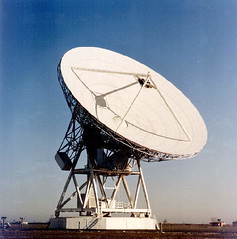SETI's Seth Shostak has written a new piece for Space dealing with the perennial concern of us having a snowball's chance in hell of picking up ET's signal given the vastness of space.
We've all heard the argument: the probability that our receiving antennas are pointed at ET's world just when their transmitting antennas are aimed at ours is vanishingly small; we’ll never arrange our telescopes to the right direction, at the right time, to pick up a signal.
Shostak is a pretty interesting guy, even if he is a contact optimist, and he provides a rather clever 'solution' to this problem.
He argues that advanced ETI's would know to transmit signals to the habitable zones of the Galaxy and that Earth is likely receiving signals as we speak. Specifically, ETI's might use a highly directional antenna (maybe an array) to beam a short, intense pulse to a long list of bio-worlds. They repeat this serial signaling project every 20 minutes, for example. If each pulse is one-thousandth of a second long, their list will comprise about a million targets, enough to provide a decent chance for including at least one star system sporting intelligent life. That’s what Shostak calls the "hailing" signal -- the one whose only purpose is to get someone’s attention.
Consequently, if an intelligence were to hear the hailing signal, they would scramble to build a a large enough receiver to pick up more complex messages from that exact spot in the cosmos. Shostak believes that it would be a relatively low-power (and therefore affordable) omnidirectional transmitter that provides the message.
As a result, argues Shostak, SETI needs to extend their "dwell" time on each target from a few minutes to a few tens of minutes, while changing their SETI receivers to more easily recognize short radio bursts.
Go, SETI!
Tags: Fermi Paradox, Life on Other Planets, Astrobiology, SETI.


No comments:
Post a Comment